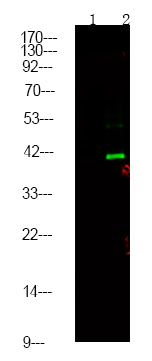CtBP1/2 (Phospho Ser158/164) rabbit pAb
- Catalog No.:YP1594
- Applications:WB;ELISA
- Reactivity:Human;Mouse;Rat
- Target:
- CtBP1/2
- Fields:
- >>Wnt signaling pathway;>>Notch signaling pathway;>>Pathways in cancer;>>Chronic myeloid leukemia
- Gene Name:
- CTBP1 CTBP
- Protein Name:
- CtBP1/2 (Phospho Ser158/164)
- Human Gene Id:
- 1487
- Human Swiss Prot No:
- Q13363/P56545
- Mouse Gene Id:
- 13016
- Mouse Swiss Prot No:
- O88712
- Rat Gene Id:
- 29382
- Rat Swiss Prot No:
- Q9Z2F5
- Immunogen:
- Synthesized peptide derived from human CtBP1/2 (Phospho Ser158/164)
- Specificity:
- This antibody detects endogenous levels of Human,Mouse,Rat CtBP1/2 (Phospho Ser158/164)
- Formulation:
- Liquid in PBS containing 50% glycerol, 0.5% BSA and 0.02% sodium azide.
- Source:
- Polyclonal, Rabbit,IgG
- Dilution:
- WB 1:1000-2000 ELISA 1:5000-20000
- Purification:
- The antibody was affinity-purified from rabbit serum by affinity-chromatography using specific immunogen.
- Concentration:
- 1 mg/ml
- Storage Stability:
- -15°C to -25°C/1 year(Do not lower than -25°C)
- Other Name:
- C-terminal-binding protein 1 (CtBP1;EC 1.1.1.-)
- Observed Band(KD):
- 48kD
- Background:
- cofactor:NAD. Required for efficient interaction with E1A. Cofactor binding induces a conformation change.,function:Involved in controlling the equilibrium between tubular and stacked structures in the Golgi complex (By similarity). Co-repressor targeting diverse transcription regulators such as GLIS2. Has dehydrogenase activity.,PTM:ADP-ribosylated; when cells are exposed to brefeldin-A (BFA).,PTM:Sumoylation on Lys-428 is promoted by the E3 SUMO-protein ligase CBX4.,PTM:The level of phosphorylation appears to be regulated during the cell cycle. Phosphorylated upon DNA damage, probably by ATM or ATR. Phosphorylation by HIPK2 on Ser-422 induces proteasomal degradation.,similarity:Belongs to the D-isomer specific 2-hydroxyacid dehydrogenase family.,subunit:Interacts with the C-terminus of adenovirus E1A protein, ELK3 and CTIP via their consensus motif P-X-[DNS]-L-[STVA]. Can form homodimers or heterodimers of CTBP1 and CTBP2. Interacts with FOXP2, HDAC4, HDAC5 and HDAC9. Interacts with GLIS2 but not GLIS1 or GLIS3 (By similarity). Interacts with FOXP1, HIPK2, PNN and NRIP1. Interacts with ZFHX1B and WIZ. Interacts with Epstein-Barr virus EBNA3 and EBNA6.,
- Function:
- negative regulation of transcription from RNA polymerase II promoter, regulation of transcription, DNA-dependent,regulation of transcription from RNA polymerase II promoter, protein amino acid phosphorylation, phosphorus metabolic process, phosphate metabolic process, Golgi organization, negative regulation of cell proliferation, negative regulation of biosynthetic process, negative regulation of macromolecule biosynthetic process, negative regulation of macromolecule metabolic process, negative regulation of gene expression, viral reproduction, phosphorylation,negative regulation of transcription, viral infectious cycle, viral genome replication, viral reproductive process, negative regulation of cellular biosynthetic process, regulation of cell proliferation, fat cell differentiation, regulation of transcription, negative regulation of transcription, DNA-dependent, negative regulation
- Subcellular Location:
- Cytoplasm . Nucleus .
- Expression:
- Expressed in germinal center B-cells.
- June 19-2018
- WESTERN IMMUNOBLOTTING PROTOCOL
- June 19-2018
- IMMUNOHISTOCHEMISTRY-PARAFFIN PROTOCOL
- June 19-2018
- IMMUNOFLUORESCENCE PROTOCOL
- September 08-2020
- FLOW-CYTOMEYRT-PROTOCOL
- May 20-2022
- Cell-Based ELISA│解您多样本WB检测之困扰
- July 13-2018
- CELL-BASED-ELISA-PROTOCOL-FOR-ACETYL-PROTEIN
- July 13-2018
- CELL-BASED-ELISA-PROTOCOL-FOR-PHOSPHO-PROTEIN
- July 13-2018
- Antibody-FAQs
- Products Images

- Western Blot analysis of 1 HepG2 cell, 2 LPS 100ng/mL 30min treated ,using primary antibody at 1:1000 dilution. Secondary antibody(catalog#:RS23920) was diluted at 1:10000


